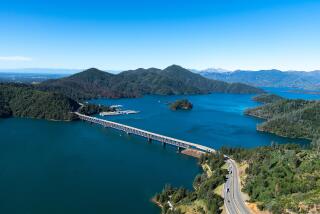‘Just Too Damn Much Water’
- Share via
An article in The Times on Thursday reminded us that the impact of the 1997 Northern California flood continues even as the sun shines on Central California. The heavy runoff has resurrected a remnant of ancient Tulare Lake, which used to cover a massive portion of the San Joaquin Valley as a matter of course--nature’s course, that is.
The magnitude of the lake also helps remind us why California north of the Tehachapis is so susceptible to flooding in spite of all the reordering humans have done to the landscape over the years with dams, levees and other hydraulic fixtures. Look at a topographic map: From Redding in the north to Bakersfield in the south, nearly 400 miles, the great Central Valley of California is a virtual bathtub.
At least 10 major river systems pour into the valley from the Sierra and the northern mountains. There is just one natural outlet, through the Sacramento-San Joaquin Delta and into San Francisco Bay.
The great flood of 1862, when Gov. Leland Stanford went to his inaugural by rowboat, created an inland sea 300 miles long, a state official noted. And this year, one farmer observed, “There’s just too damn much water.”
One reason the January flood threatened to overwhelm the protective works of humans was the intensity of the rainfall and the sudden massive inflow into the state’s big reservoirs.
On. Dec. 31 and Jan. 1, the inflow from the Feather River to Lake Oroville raged at nearly twice the amount that could be released from the dam. Between Dec. 26 and Jan. 2, more than 33 inches of rain fell at Blue Canyon in the Feather River’s headwaters--more than 11 inches on New Year’s Day alone.
“This was a historic intensive storm,” said David N. Kennedy, director of the state Department of Water Resources. The weather experts were baffled. No one knew for sure what caused the storm to act as it did.
The short-range forecasts were even worse on New Year’s Day, Kennedy said, and he feared major flooding in Sacramento. But suddenly and unexpectedly, the storm shifted to the south. The devastation that might have befallen Sacramento occurred to a lesser degree along rivers to the south.
Water department statistics dramatize the effect of that shift. The runoff into Lake Oroville and Lake Shasta for the three-day storm peak far surpassed the levels of the 1986 flood. At Folsom Lake just above Sacramento, the inflow was slightly less than in 1986.
A catastrophe may have been averted, but that had little to do with mortal efforts to contain the water. It was nature’s call. Or as the farmer said, “Just too damn much water.”
More to Read
Sign up for Essential California
The most important California stories and recommendations in your inbox every morning.
You may occasionally receive promotional content from the Los Angeles Times.













